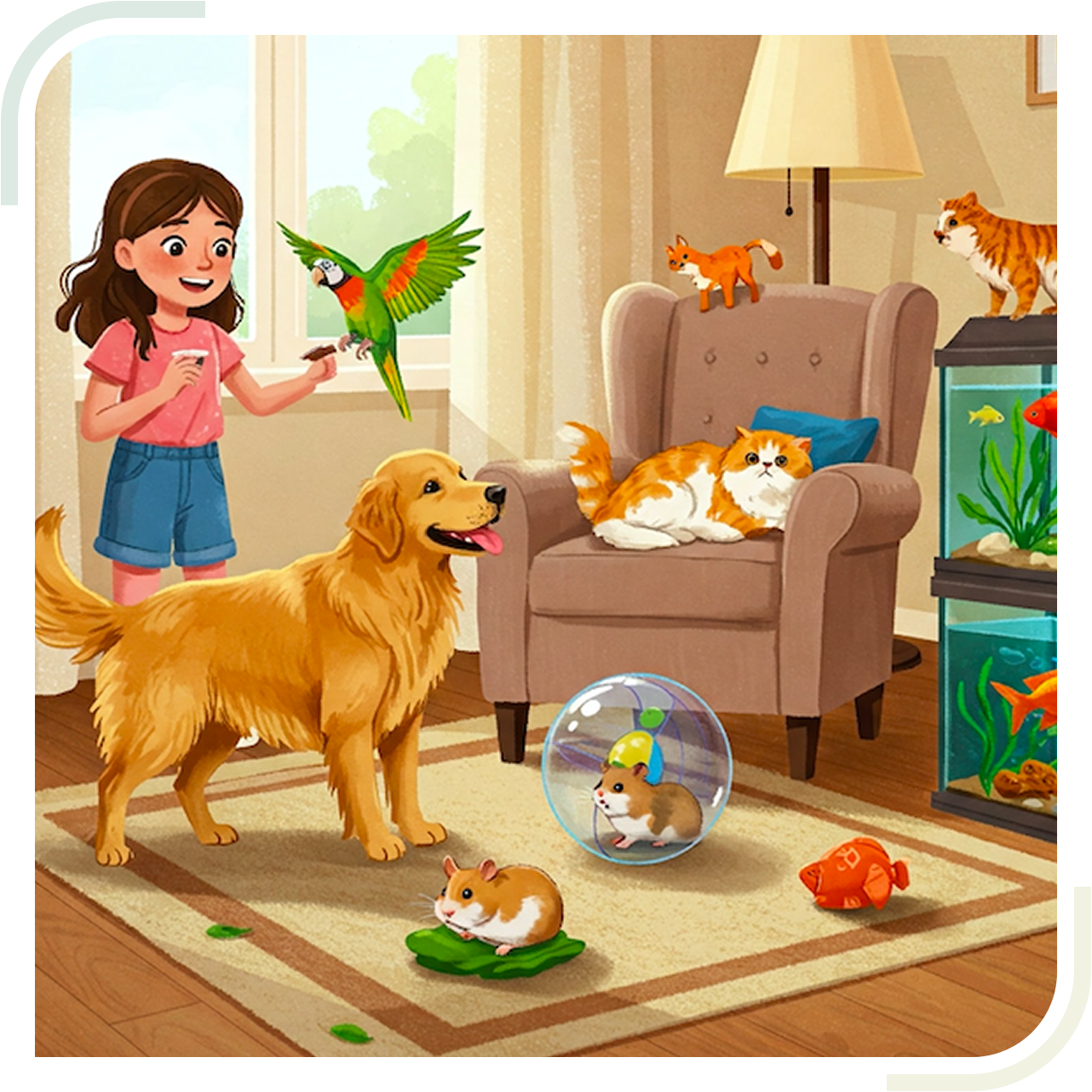Beyond Cuddles: How to Keep Your ESA Mentally Stimulated
Your Emotional Support Animal (ESA) provides invaluable comfort and companionship, helping to alleviate symptoms of your mental or emotional disability. While their mere presence is therapeutic, an ESA is still an animal with natural instincts and needs. Just like humans, animals require mental stimulation to thrive. A bored or under-stimulated ESA can develop behavioral issues that might inadvertently add stress to your life, counteracting their supportive role. Keeping your ESA mentally engaged is crucial for their well-being, strengthening your bond, and ensuring they remain a calm, positive presence in your life.
Why Mental Stimulation Matters for ESAs
Mental stimulation is as important as physical exercise for any animal. Here’s why it’s particularly beneficial for your ESA:
-
Prevents Boredom and Destructive Behaviors: A lack of mental engagement can lead to boredom, which often manifests as destructive behaviors like excessive chewing, scratching, or excessive barking/meowing. Keeping their minds active can redirect these urges.
-
Reduces Anxiety and Stress: Engaging an animal’s mind can reduce overall anxiety and stress levels. It provides an outlet for their energy and helps them feel more fulfilled, leading to a calmer demeanor. This directly benefits you, as a calm animal contributes to a calm environment.
-
Enhances Bond and Communication: Interactive games and training sessions are excellent opportunities to strengthen the bond between you and your ESA. They foster communication and mutual understanding, deepening the therapeutic connection.
-
Boosts Confidence: Successfully solving a puzzle or learning a new command gives an animal a sense of accomplishment, boosting their confidence and overall happiness.
-
Supports Cognitive Health: Regular mental exercise helps keep an animal’s brain sharp, potentially slowing cognitive decline, especially in older ESAs.
Strategies for Mentally Stimulating Your ESA
Regardless of whether your ESA is a dog, cat, or another animal, there are numerous ways to provide enriching mental activities.
For Canine ESAs:
Dogs are intelligent and eager to learn, making mental stimulation relatively easy to incorporate:
-
Puzzle Toys and Food Dispensers:
- Description: These toys require your dog to manipulate them to release treats or kibble. Examples include KONGs filled with peanut butter, snuffle mats, or interactive feeders.
- Benefit: They challenge your dog to think and problem-solve, making mealtime an engaging activity rather than just a quick eat. This can occupy them for extended periods.
-
Obedience Training and New Tricks:
- Description: Beyond basic commands, teach your dog fun new tricks like “shake a paw,” “roll over,” “play dead,” or even stringing commands together.
- Benefit: Learning is mentally taxing and rewarding for dogs. It also reinforces your bond and improves their responsiveness to your commands. Consistent, positive reinforcement training is key.
-
Scent Work and “Find It” Games:
- Description: Dogs have an incredible sense of smell. Hide treats or their favorite toys around the house (or yard) and encourage them to “find it.” You can start easy and gradually increase the difficulty.
- Benefit: This taps into their natural instincts and provides a highly engaging mental workout. Nose work classes or kits are also available.
-
Structured Walks and “Sniffaris”:
- Description: Instead of just a brisk walk, allow your dog time to stop and sniff extensively. Take them to new routes or parks to explore different smells and sights.
- Benefit: Smelling is a primary way dogs interpret the world. A “sniffari” is incredibly mentally stimulating, allowing them to process new information and feel more engaged with their environment.
-
Interactive Play:
- Description: Games like fetch, tug-of-war (with rules), or even just chasing a flirt pole engage your dog’s mind as well as their body.
- Benefit: These activities require dogs to think about strategy and anticipation, making them more than just physical exercise.
-
Canine Enrichment Classes:
- Description: Consider enrolling in dog sports like agility, rally obedience, or even canine freestyle. Look for local dog training centers in Nunica, Michigan, or nearby communities that offer such classes.
- Benefit: These structured activities provide intense mental and physical stimulation and can be a great way to bond.
For Feline ESAs:
Cats are often perceived as independent, but they too benefit immensely from mental enrichment tailored to their predatory instincts:
-
Puzzle Feeders and Food Dispensing Toys:
- Description: Similar to dogs, cats can benefit from toys that dispense kibble or treats when manipulated. Examples include treat balls, puzzle boards, or automated feeders.
- Benefit: This makes mealtime more engaging and slows down eating, tapping into their natural hunting behaviors.
-
Interactive Play with “Prey”:
- Description: Use wand toys, laser pointers (with a treat at the end!), or feather teasers to simulate hunting. Move the toy like prey – hiding, darting, and pausing.
- Benefit: This fulfills their innate predatory drive, which is mentally stimulating and physically active. It’s crucial to let them “catch” the toy sometimes to prevent frustration.
-
Vertical Space and “Catification”:
- Description: Provide cat trees, shelves, window perches, or even secure outdoor “catios.” Consider placing perches near windows with bird feeders for outdoor viewing, a natural mental stimulant for cats.
- Benefit: Cats love to climb and observe their territory from high vantage points. This adds mental engagement by giving them new perspectives and areas to explore.
-
Scratching Posts and Boards (Varieties):
- Description: Offer different types of scratching surfaces (vertical, horizontal, cardboard, sisal, carpet) in various locations.
- Benefit: Scratching is a natural cat behavior that helps them stretch, mark territory, and relieve stress. Providing appropriate outlets prevents destructive scratching elsewhere.
-
Training (Yes, Cats Can Be Trained!):
- Description: Cats can learn tricks like “sit,” “stay,” “high five,” or even walking on a leash. Use positive reinforcement and short, frequent sessions.
- Benefit: Training provides mental challenge and strengthens the bond. It can also help manage certain behaviors.
-
“Enrichment Boxes” and Rotation of Toys:
- Description: Provide a rotating selection of toys. You can also create simple “enrichment boxes” with paper bags (handles cut off!), empty cardboard boxes, or crinkly paper for them to explore.
- Benefit: Novelty keeps cats interested. A fresh “new” toy every few days or weeks can spark their curiosity.
General Tips for All ESAs
-
Observe Your ESA: Pay attention to what kinds of activities your animal genuinely enjoys and responds to. Tailor your enrichment strategies to their individual personality and preferences.
-
Consistency is Key: Regular mental stimulation, even in short bursts, is more effective than occasional long sessions. Incorporate it into your daily routine.
-
Keep It Positive: Always use positive reinforcement (treats, praise, petting) to encourage engagement and make mental activities enjoyable. Avoid punishment.
-
Vary Activities: Just like humans, animals can get bored with the same old routine. Rotate toys, introduce new games, and explore different environments.
-
Know When to Stop: Don’t force interaction if your ESA isn’t in the mood. Respect their cues and try again later.
Conclusion: A Stimulated ESA is a Happy ESA
Your Emotional Support Animal is there for you, providing comfort and stability. By dedicating time and effort to their mental stimulation, you reciprocate that care, ensuring they are healthy, happy, and well-adjusted companions. A mentally stimulated ESA is less likely to exhibit undesirable behaviors and more likely to remain a calm, supportive, and joyful presence in your life. Investing in their mental well-being is an investment in your own, strengthening the unique and vital bond you share.
References
American Veterinary Medical Association. (n.d.). Environmental Enrichment. Retrieved from https://www.avma.org/resources-tools/pet-owners/pet-care/environmental-enrichment
Overall, K. L. (2013). Manual of Clinical Behavioral Medicine for Dogs and Cats. Mosby Elsevier.
Sheppard, G., & Mills, D. S. (2003). The effect of olfactory stimulation on the behaviour of dogs in a public animal shelter. Applied Animal Behaviour Science, 83(2), 115-121.





